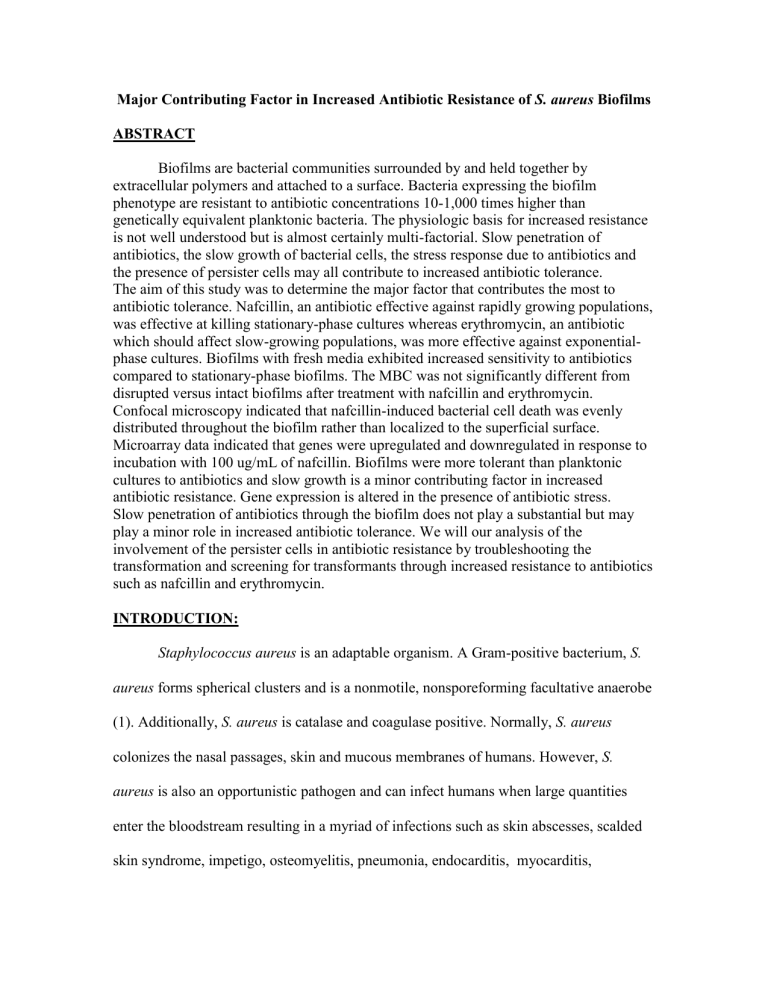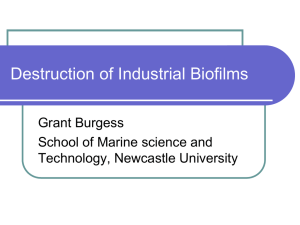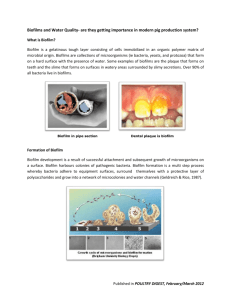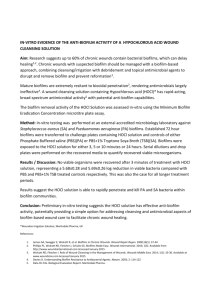Major Contributing Factor in Increased Antibiotic Resistance of S

Major Contributing Factor in Increased Antibiotic Resistance of S. aureus Biofilms
ABSTRACT
Biofilms are bacterial communities surrounded by and held together by extracellular polymers and attached to a surface. Bacteria expressing the biofilm phenotype are resistant to antibiotic concentrations 10-1,000 times higher than genetically equivalent planktonic bacteria. The physiologic basis for increased resistance is not well understood but is almost certainly multi-factorial. Slow penetration of antibiotics, the slow growth of bacterial cells, the stress response due to antibiotics and the presence of persister cells may all contribute to increased antibiotic tolerance.
The aim of this study was to determine the major factor that contributes the most to antibiotic tolerance. Nafcillin, an antibiotic effective against rapidly growing populations, was effective at killing stationary-phase cultures whereas erythromycin, an antibiotic which should affect slow-growing populations, was more effective against exponentialphase cultures. Biofilms with fresh media exhibited increased sensitivity to antibiotics compared to stationary-phase biofilms. The MBC was not significantly different from disrupted versus intact biofilms after treatment with nafcillin and erythromycin.
Confocal microscopy indicated that nafcillin-induced bacterial cell death was evenly distributed throughout the biofilm rather than localized to the superficial surface.
Microarray data indicated that genes were upregulated and downregulated in response to incubation with 100 ug/mL of nafcillin. Biofilms were more tolerant than planktonic cultures to antibiotics and slow growth is a minor contributing factor in increased antibiotic resistance. Gene expression is altered in the presence of antibiotic stress.
Slow penetration of antibiotics through the biofilm does not play a substantial but may play a minor role in increased antibiotic tolerance. We will our analysis of the involvement of the persister cells in antibiotic resistance by troubleshooting the transformation and screening for transformants through increased resistance to antibiotics such as nafcillin and erythromycin.
INTRODUCTION:
Staphylococcus aureus is an adaptable organism. A Gram-positive bacterium, S. aureus forms spherical clusters and is a nonmotile, nonsporeforming facultative anaerobe
(1). Additionally, S. aureus is catalase and coagulase positive. Normally, S. aureus colonizes the nasal passages, skin and mucous membranes of humans. However, S. aureus is also an opportunistic pathogen and can infect humans when large quantities enter the bloodstream resulting in a myriad of infections such as skin abscesses, scalded skin syndrome, impetigo, osteomyelitis, pneumonia, endocarditis, myocarditis,
pericarditis, enterocolitis, mastitis, cystitis, cervicitis, prostatitis, cerebritis, toxic shock syndrome, meningitis, bacteremia and abscesses of muscle, skin and internal organs (1).
In the presence of environmental challenges, S. aureus can alter its genotype and/or phenotype to adapt to its surroundings. One clinically important adaptation is resistance to antibiotics. An example of a genotypic change leading to antibiotic resistance is the acquisition by S. aureus of the β-lactamase gene conferring penicillin resistance. (4) The formation of biofilms is an example of a phenotypic change that results in increased antibiotic resistance.
Biofilms, or aggregations of sessile bacteria surrounded by a polymeric matrix
(2), are a leading cause of chronic nosocomial infections. Diseases such as endocarditis, osteomyelitis and medical-device related infections are caused by S. aureus biofilms and are not readily treatable with antibiotics. In fact, biofilms are resistant to antibiotic levels
10- to 1,000-fold higher than planktonic, or free-floating, bacteria (2).
The properties of biofilms resulting in their increased resistance to antibiotics are not thoroughly understood. The close contact between bacteria within a biofilm and the matrix may inhibit efficient penetration of antibiotics through the exopolysaccharide matrix (3). Biofilm bacteria also exhibit a slow rate of metabolism and divide infrequently resulting in decreased sensitivity to antibiotics targeted at cell wall synthesis such as beta-lactam penicillins (2). However, even antibiotics targeted at cellular functions such as protein and DNA synthesis, which should affect slow-growing bacteria exhibit reduced efficacy against biofilms. Bacterial cells in a biofilm can also mount a stress response in the presence of an antibiotic although the transcriptional profile is not thoroughly understood. The phenotypic heterogeneity of bacteria in a biofilm suggests
the presence of persister cells or antibiotic-resistant, non-dividing cells which are able to reestablish the biofilm after the threat has passed (5). Despite the number of theories about biofilm resistance to antibiotics, little research has been conducted on persister cells in S. aureus biofilms and the contributions of the properties of biofilms to resistance are not well understood.
In the study, we attempted to determine the major factor in the increased antibiotic tolerance to biofilms. Our research focused on four factors potentially contributing to antibiotic tolerance: (1) slow growth, (2)stress response, (3) slow penetration and (4) persister cells. To determine the contribution of slow growth, we compared the sensitivity of exponential-phase culture of S. aureus to stationary phase cultures and we compared the efficacy of antibiotics which dependant upon rapid growth for killing (i.e. nafcillin) to that of antibiotics which are not affected by the growth rate, such as not erythromycin using a MBC (minimum bactericidal concentration) assay. We performed a microarray experiment comparing the transcriptional profile of biofilm cells treated with nafcillin to a control to determine the genes that are upregulated and downregulated in response to antibiotic stress. To determine the contribution of slow penetration, we were attempting to elucidate the importance artichtecture of the biofilm important and if bacteria on the periphery get killed while those in deeper layers survive.
We disrupted biofilms and visualized intact and disrupted biofilms treated with nafcillin using confocal microscopy and we performed an MBC assay comparing the MBC values of intact and disrupted biofilms treated with nafcillin and erythromycin. We examined the importance of persister cells by creating a genomic expression library to isolate the genes responsible for the persister phenotype in the S. aureus genome. From these experiments,
it will be possible to conclude which factors contribute substantially to increased antibiotic tolerance of biofilms and to determine if biofilm-related tolerance is indeed multifactorial.
METHODS:
Strains and growth conditions : S. aureus strains SA113, RN4220 and 10833 were grown in Tryptic Soy Broth (TSB), Tryptic Soy Broth + 1% glucose (TSBG) or Brain
Heart Infusion + 1% glucose (BHIG) as indicated. SA113 was plated on Tyrptic Soy
Agar (TSA) plates. Transformed E. coli cells were plated on Luria-Bertani (LB) + 100 ug/mL of ampicillin.
Slow Growth:
Minimum Bactericidal Concentration (MBC) Assay :
Biofilms : Two 6-well plates containing 2 mL of SA113 + TSB + RN4220 per well were incubated in the warm room overnight. The mediawas removed from two wells in each plate and fresh media was added for the fed condition. The plates were incubated in the warm room for two hours and two other wells on each plate were disrupted by pipetting.
One plate received antibiotic treatment with erythromycin and nafcillin while the other served as the control. The plates were incubated for 3 hours, disrupted via pipetting and serial 10 fold dilutions of the cultures were plated on TSA plates to determine colony formingunits (CFU).
Planktonic : Six 50 mL conical tubes containing 5 mL of TSBG + RN4220 were incubated at 37 degrees overnight. Three of the tubes were spun down and resuspended in
5 mL of TSBG to achieve exponential phase while the other three remainded in stationary phase. After 2 hours, three of the tubes received treatment with erythromycin while the other three were treated with nafcillin. After a three-hour incubation period at 37 degrees, serial 10-fold dilutions of the cultures were plated on TSA plates to determine colony forming units (CFU).
Stress Response:
Microarray: RNA was extracted from untreated SA113 biofilms and biofilms incubated with 100
g/mL of nafcillin. After the RNA was purified, cDNA was produced using reverse transcriptase. cDNA from treated and untreated biofilms was labeled with a red
(Cy5) or green (Cy3) fluorescent dye and hybridized to a slide microarray spotted with
DNA oligonucleotides that correspond to the majority of genes in the staphylococcal genome. The slide arrays were washed with stringency buffers and scanned using lasers that excite the fluorophores (Cy3=550nm, Cy5-650 nm). Fluorescent emissions were recorded (Cy3=570nm, Cy5-670 nm) by the scanner.
Slow Penetration:
Minimum Bactericidal Concentration (MBC) Assay : Half of 24 hr-old SA113 biofilms were disrupted by pipetting and the other half remainded intact. Both conditions were treated with serial dilutions of nafcillin and erthyomycin. After 4 hours, the antibiotic was removed, the biofilms were all disrupted and serial 10-fold dilutions of the cultures were plated on TSA plates to determine colony forming units (CFU).
Confocal Microscopy: Overnight cultures of untreated SA113 in BHIG and SA113 incubated with 100
g/mL of nafcillin were treated with BacTiter LIVE/DEAD
Viability/Cytotoxicity dyes to visualize the viability of cells. Plates were analyzed using the confocal microscope and images displaying the red (dead) and green (alive) cells were saved.
Genomic Expression Library/Persister Cells:
Isolation of genomic DNA : Overnight cultures of S. aureus strain 10833 in 50 mL of
TSB were centrifuged at 4000 rpm for 20 minutes at 4 degrees C. The pellets were resuspended in 7 mL of lysis buffer and were incubated with 50 uL of lysostaphin for 30 minutes at 37 degrees C. After 30 minutes, 100 uL of proteinase K was added and the solution was mixed by inversion and incubated for 1 hour at 65 degrees C in a water bath.
DNA extractions were performed using phenol and chloroform. 7 mL of 1:1 phenol/chloroform was added and the solution was vortexed and then centrifuged at
12000 rpm for 5 minutes at 4 degrees C. The upper aqueous layer was removed and added to a new microfuge tube followed by another 7 mL chloroform extraction, vortexing and centrifugation (x 2). The top layer was removed and added to a new microfuge tube and 1/10 the volume of sodium acetate and 2 times the volume of cold
100% ethanol was added to isolate the DNA. Precipitation was performed by incubating at -20 degrees C for 1 hour followed by centrifugation for 1 hour at 12000 rpm at 4 degrees C. The DNA pellet was washed gently with 75% ethanol and air dried for 10 minutes. The pellet was resuspended with ~250-500 uL of nuclease/RNase free water and stored at -20 degrees C. pCL15 plasmid maxiprep: A colony from a freshly streaked E. coli on LB + Amp plate was picked and inoculated in 100 mL of fresh LB + Amp overnight in the 37 degree C shaking incubator. The cells were harvested by centrifugation at 6000 x g for 15 minutes at 4 degrees. The pellet was resuspended in 10 ml of Buffer P1. The solution was transferred to a 30 ml centrifuge tube. 10 mL of Buffer P2 was added and the tube was invert 4-6 times to mix the solution and incubated at room temperature for 5 minutes. 10 mL of cold Buffer P3 was added to the lysis reaction and the solution was mixed gently
4-6 times and set on ice for 20 minutes. Following precipitation, the tube was centrifuged at 20,000 x g for 30 minutes at 4 degrees. The supernatant containing plasmid DNA was immediately transferred to a clean 30 mL tube and the spin (20,000 x g) was repeated for
15 minutes at 4 degrees. While spinning, a QIAGEN-tip 500 was equilibrated with 10 mL of Buffer QBT. The supernatant was promptly applied to the column and allowed to enter
the resin by gravity flow. The column was washed twice with 30 mL of Buffer QC. The
DNA was eluted with 15 mL of Buffer QF. The DNA was precipitated with 10.5 mL of room-temperature isopropanol. The solution was mixed and centrifuged at 15,000 x g for
30 minutes at 4 degrees. The supernatant was decanted and the DNA pellet was washed with 5 mL of room-temperature 70 % ethanol and centrifuged again at 15,000 x g for 10 minutes. The supernatant was decanted and the pellet was air-dried for 10 minutes. The pellet was resuspended in 200 uL of dd water and stored in the -20 degrees C freezer.
Digestion of genomic DNA with Sau3A1: A mixture of 140 uL of genomic DNA, 35 uL of Buffer 7 uL of BSA and 154 uL of DNA water was incubated for 30 minutes in the 37 degree water bath and digested with 14 uL of restriction enzyme Sau3A1. The reaction proceeded for 30 minutes and the DNA fragments were gel purified and extracted in accordance with the QIAGEN gel extraction protocol.
Digestion of pCL15 with BamH1 : A mixture of 5 uL pCL15, 5 uL Buffer 3, 1 uL BSA,
35 uL DNA water and 2 uL of the BamH1 restraction enzyme was incubated in the 37 degree water bath for 2 hours. Incubation was followed by two digestions with .5 uL of
Ciap and 15 minute incubation periods to dephosphorylate the ends of the linearized plasmid. The plasmid DNA was gel purified and gel extracted accordance with the
QIAGEN gel extraction protocol.
Ligation : In the T4 DNA ligase reaction tube, 15 uL of digested Sau3A1 genomic DNA and 5 uL of BamH1 digested pCl15 were added and vortex to thoroughly mix the solution. The contents were transferred to a PCR tube and incubated at 15 degree C for 1 hour.
Transformation : A tube containing E. coli competent cells were stored on ice. From the ligation reaction, 4 uL was transferred to the competent cells and set on ice for 5 minutes.
The cells were heat-shocked for 30 seconds at 42 degrees C and 250 uL of SoC media was immediately added. The transformed cells were incubated at 37 degrees C for 1 hour and 150 uL was streaked onto two LB+ Amp plates. The plates were stored in the warm room overnight.
Miniprep: Four colonies from the E. coli plates onto LB + Amp were inoculated in small cap tubes containing 5 mL of TSB + 5 uL of ampicillin and stored in the 37 degree shaking incubator overnight. The 4 cultures were centrifuged at 14,000 rpm for 5 minutes and the supernatant was removed. Each pellet was resuspended in 250 uL of Buffer PI.
250 uL of Buffer P2 was added to each tube and was inverted 4-6 times to mix the solution. 350 uL of Buffer N3 was added and the tubes were mixed quickly by inversion
4-6 times. The tubes were centrifuged for 10 minutes at 13,000 rpm and the supernatants were removed and added to each spin column. The columns were centrifuged again for 1 minute and the flows-through were discarded. The columns were washed by adding 0.75 mL of Buffer PE and centrifuged again for a minute. The flows-through were discarded and the columns were centrifuged again for a minute to remove the extra wash buffer.
The columns were transferred to new microcentrifuge tubes and 40 uL of DNA were added to the center of each column and centrifuged for 1 minute. The eluted water was
run through each column one more time and centrifuged for 1 minute to elute the purified plasmid DNA.
Miniprep Digestion: For each plasmid, 8 uL of plasmid DNA, 2.5 uL EcoRI Buffer,
12.5 uL of DNA water, 1 uL EcoRI and 1 uL Pst1 was added to each eppendorf and the reactions were incubated in the 37 degree C water bath for 1 hour. The digested plasmid
DNA was run on a gel and visualized.
RESULTS:
Slow Growth: To determine the sensitivity of stationary-phase cultures, slow-growing planktonic cultures, compared to exponential growing cultures (fast growing planktonic cultures), we performed an MBC assay where both growth-phase cultures where incubated with nafcillin and erythromycin (Figure 1). The percentage of bacteria in stationary phase that survived treatment with erthyomycin was lower than that of those treated with nafcillin indicating that erythromycin was more effective against slowgrowing bacteria, Nafcillin, on the other hand, was much more effective against rapidly growing bacteria as indicated by the smaller percentage of exponential-growing bacteria that survived treatment with nafcillin compared to those treated with erythromycin.
Biofilms were much more tolerant to both antibiotics than planktonic cultures where there was not a significant difference between efficacy of the two antibiotics. Fresh medium cells exhibited a slight increase in sensitivity to the antibiotics compared to the stationary phase biofilm cells which may result from the addition of fresh medium which temporarily increased the growth rate of constituent bacteria.
Stress Response: We performed a microarray analyzis comparing the genes upregulated/downregulated in biofilms treated with nafcillin to a control biofilm to determine the transcriptional profile of biofilm cells in response to antibiotic stress. We identified 10 genes, 4 displaying upregulation and 6 displaying downregulation in the presence of nafcillin (Figure 2). Using Basic Local Alignment Search Tool (BLAST), we determined that the genes correspond to proteins with unknown functions, otherwise referred to as hypothetical proteins suggesting that genes are both upregulated and downregulated in response to nafcillin.
Slow Penetration : To determine if biofilm architectures contributes to increased antibiotic tolerance, we performed an MBC assay comparing intact and disrupted biofilms treated with nafcillin and erythromycin (Figure 3). The lack of a significant difference in the percentage of bacteria surviving antibiotic treatment between intact and disrupted biofilms for both antibiotics suggests that disruption affected both antibiotics fairly equally although erythromycin was more effective than nafcillin against the biofilms overall. To determine if cells on the periphery were killed while cells in the interior of a biofilm survive, biofilms treated with nafcillin and control biofilms were incubated with Live/DEAD two-color assay dyes and visualized with confocal microscopy. Alive cells were strained green while dead cells were strained red. The images displaying alive cells for both the control and the nafcillin-treated biofilms
(Figure 4) indicate that there were less alive cells in the nafcillin-treated biofilms, as
expected. The dead cells in the control and nafcillin-treated biofilms (Figure 5) were distributed evenly throughout both biofilms although there was a larger number of red, dead cells in the nafcillin-treated biofilm suggesting that the antibiotic was able to penetrate the biofilm and kill cells on the periphery and the interior relatively equally.
Genomic Expression Library: To identify the genes in the S. aureus genome that control the persister phenotype, we created a genomic expression library. Although we were able to digest the genomic DNA with Sau3A1 (Figure 6), the ligation reaction was not able to produce the thousands of transformants necessary to produce a genomic library. Also, the miniprep plasmids from the isolated transformants did not contain the desired persister gene of interest in the 6-2 kb region once we ran the digested plasmid
DNA on a gel.
100.00
Nafcillin
80.00
Erm
Percent surviving bacteria
60.00
40.00
20.00
0.00
Stationary Exponential Stationary Fresh medium
Planktonic Biofilm
Figure 1.
Graph of the percentage of surviving bacteria after antibiotic treatment for planktonic and biofilm bacteria in stationary or exponential phase treated with nafcillin and erythromycin. Erythomycin was more effective against stationary-phase bacteria whereas nafcillin was more effective against exponential-phase bacteria. Biofilm bacteria were much more tolerant to antibiotics than planktonic bacteria although biofilms supplemented with fresh medium exhibited an increased sensitivity to antibiotics than stationary-phase biofilms. The percentage survival was calculated as 1-treated/untreated times 100%.
Gene
SAS050
SA2331
SA1266
Upregulated Downregulated
7.88x
4.06x
4.03x
SA0267 2.66x
SAR0626
SACOL1579
SAS2352
2.85x
2.92x
3.40x
SAV0901
SA1927
SACOL1788
4.85x
4.89x
9.90x
Figure 2. Table showing genes identified from microarrays as upregulated or downregulated after exposure to 100
g/mL of nafcillin. The numbers are corresponding to the magnitude of upregulation or downregulation as compared to the control values.
100.00
90.00
80.00
Control
70.00
60.00
Disrupted
Percent surviving bacteria
50.00
40.00
30.00
20.00
10.00
0.00
Nafcillin Erythromycin
Figure 3.
Graph of the percentage of surviving bacteria after antibiotic treatment for intact and disrupted biofilms treated with nafcillin and erythromycin. There was not a significant difference in viability between control and disrupted biofilms after treatment with both antibiotics. The percentage survival was calculated as 1treated/untreated times 100%.
Control Nafcillin-treated
Control
Figure 4.
Confocal microscopy images revealing viable bacteria following treatment with 100
g nafcillin/mL overnight. Some loss in viability was observed, however cell death did not appear to be localized within a specific region of the biofilm.
Control Nafcillin-treated
Figure 5. Confocal microscopy images revealing dead bacteria following treatment with 100
g nafcillin/mL overnight. Some cell death was observed in the absence of antibiotic treatment, however the number of dead bacteria was greater following nafcillin treatmen. Nafcillin-mediated killing appeared to occur homogeneously throughout the biofilm, rather than being localized to the superficial layers.
Ladder Digested DNA
Figure 6. Gel electrophoresis image of digested Sau3A1 genomic DNA. The orange box corresponds to the desired fragment between 6-2 kb which was subsequently excised from the gel and purified.
DISCUSSION:
From the aforementioned experiments, we were able to identify some of the major factors contributing to increased antibiotic tolerance. Slow growth does appear to play a role in increased antibiotic tolerance although not a substantial one because stationaryphase biofilms were only slightly more tolerant than biofilms with fresh media. The biofilms were overall more sensitive to erythromycin than nafcillin which suggests that erythromycin is affected by growth-rate to some extent especially since the biofilms with fresh media would be conceivably producing more proteins.
With regard to stress response, gene expression is altered in the presence of nafcillin. The unidentified genes may correspond to virulence factors although the results are preliminary and more microarrays would have to be performed in the future to truly identify the genes and the functions of their proteins. Biofilm architecture does not play a substantial role as indicated by the MBC assay and the insignificant difference percentage survival between disrupted and intact biofilms treated with both antibiotics. Additionally, the morphology of the biofilm was not able to prevent the antibiotic from penetrating the layers of the biofilm suggesting that the architecture does not contribute that much to increased antibiotic tolerance and that the cells on the periphery are not completely destroyed while those in the interior remain alive.
The role of persister cells still needs to be investigated since we were not able to create an adequate genomic expression library. Although persister cells are considered to
Contribute substantially to increased antibiotic tolerance (6), it is quite possible that they may not play as large a role as expected given the seemingly significant contributions of gene expression and possibly biofilm architecture. In order to verify these claims, in the future we will continue to troubleshoot the transformation in order to generate the thousands of transformants necessary to move on to the screening stage of the genomic library protocol. Additionally, we will screen for transformants using increased resistance to antibiotics such as nafcillin and erythromycin. Despite these difficulties, we have determined that many biofilm-related factors work together to contribute to increased antibiotic tolerance suggesting that tolerance is not dependant on a single factor.
REFERENCES
1. Götz, F., T. Bannerman, and K.-H. Schleifer. (2006). The Genera
Staphylococcus and
Macrococcus. In: The Prokaryotes: A Handbook on the Biology of Bacteria: Firmicutes:
Firmicutes with Low GC Content of DNA (Dworkin, M., Falkow, S., Rosenberg, E.,
Schleifer, H.-K., Stackebrandt, E., eds.). Springer New York, NY, pp. 11-59
2. Monroe, D. (2007). Looking for Chinks in the Armor of Bacterial Biofilms. PLoS
Biology . 5(11): 2458.
3. Jefferson K. K., D. A. Goldmann, and G. B. Pier. (2005). Use of confocal microscopy to analyze the rate of vancomycin-binding in Staphylococcus aureus biofilms.
Antimicrob. Agents Chemother.
49(6): 2467-2473.
4. Couto, I., S. W. Wu, A. Tomasz, and H. de Lencastre. (2003). Development of methicillin resistance in clinical isolates of Staphylococcus sciuri by transcriptional activation of the mecA homologue native to the species. J Bacteriol. 185(2): 645–653.
5. Lewis, K. (2007). Persister cells, dormancy and infectious diseases. Nature . 5: 47.
6. Singh, R., P. Ray, A. Das, and M. Sharma. (2009) Role of persisters and small colony variants in antibiotic resistance of planktonic and biofilm-associated Staphylococcus aureus : an in vitro study. Journal of Medical Microbiology Papers in Press.
1-26.







